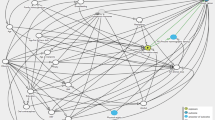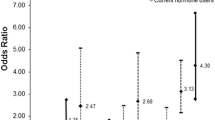Abstract
Purpose
Mammographic density is a measurable and modifiable biomarker that is strongly and independently associated with breast cancer risk. Paradoxically, although Asian women have lower risk of breast cancer, studies of minority Asian women in predominantly Caucasian populations have found that Asian women have higher percent density. In this cross-sectional study, we compared the distribution of mammographic density for a matched cohort of Asian women from Malaysia and Caucasian women from Sweden, and determined if variations in mammographic density could be attributed to population differences in breast cancer risk factors.
Methods
Volumetric mammographic density was compared for 1501 Malaysian and 4501 Swedish healthy women, matched on age and body mass index. We used multivariable log-linear regression to determine the risk factors associated with mammographic density and mediation analysis to identify factors that account for differences in mammographic density between the two cohorts.
Results
Compared to Caucasian women, percent density was 2.0% higher among Asian women (p < 0.001), and dense volume was 5.7 cm3 higher among pre-menopausal Asian women (p < 0.001). Dense volume was 3.0 cm3 lower among post-menopausal Asian women (p = 0.009) compared to post-menopausal Caucasian women, and this difference was attributed to population differences in height, weight, and parity (p < 0.001).
Conclusions
Our analysis suggests that among post-menopausal women, population differences in mammographic density and risk to breast cancer may be accounted for by height, weight, and parity. Given that pre-menopausal Asian and Caucasian women have similar population risk to breast cancer but different dense volume, development of more appropriate biomarkers of risk in pre-menopausal women is required.

Similar content being viewed by others
References
Chia KS, Reilly M, Tan CS et al (2005) Profound changes in breast cancer incidence may reflect changes into a Westernized lifestyle: a comparative population-based study in Singapore and Sweden. Int J Cancer 113(2):302–306. doi:10.1002/ijc.20561
Sung H, Rosenberg PS, Chen WQ et al (2015) Female breast cancer incidence among Asian and Western populations: more similar than expected. J Natl Cancer Inst. doi:10.1093/jnci/djv107
Porter P (2008) “Westernizing” women’s risks? Breast cancer in lower-income countries. New Engl J Med 358(3):213–216. doi:10.1056/NEJMp0708307
van den Brandt PA, Spiegelman D, Yaun SS et al (2000) Pooled analysis of prospective cohort studies on height, weight, and breast cancer risk. Am J Epidemiol 152(6):514–527
Nechuta S, Paneth N, Velie EM (2010) Pregnancy characteristics and maternal breast cancer risk: a review of the epidemiologic literature. Cancer Causes Control CCC 21(7):967–989. doi:10.1007/s10552-010-9524-7
Chlebowski RT, Hendrix SL, Langer RD et al (2003) Influence of estrogen plus progestin on breast cancer and mammography in healthy postmenopausal women: the Women’s Health Initiative Randomized Trial. JAMA 289(24):3243–3253. doi:10.1001/jama.289.24.3243
McCormack VA, dos Santos Silva I (2006) Breast density and parenchymal patterns as markers of breast cancer risk: a meta-analysis. Cancer Epidemiol Biomark Prev 15(6):1159–1169. doi:10.1158/1055-9965.EPI-06-0034
Boyd NF, Byng JW, Jong RA et al (1995) Quantitative classification of mammographic densities and breast cancer risk: results from the Canadian National Breast Screening Study. J Natl Cancer Inst 87(9):670–675
Ursin GQS (2009) Mammographic density—a useful biomarker for breast cancer risk in epidemiologic studies. Norsk Epidemiol 19(1):59–68
Boyd NF, Lockwood GA, Martin LJ et al (2001) Mammographic density as a marker of susceptibility to breast cancer: a hypothesis. IARC Sci Publ 154:163–169
Ellison-Loschmann L, McKenzie F, Highnam R et al (2013) Age and ethnic differences in volumetric breast density in new zealand women: a cross-sectional study. PLoS ONE 8(7):e70217. doi:10.1371/journal.pone.0070217
Maskarinec G, Meng L, Ursin G (2001) Ethnic differences in mammographic densities. Int J Epidemiol 30(5):959–965
Heller SL, Hudson S, Wilkinson LS (2015) Breast density across a regional screening population: effects of age, ethnicity and deprivation. Br J Radiol 88(1055):20150242. doi:10.1259/bjr.20150242
Habel LA, Capra AM, Oestreicher N et al (2007) Mammographic density in a multiethnic cohort. Menopause 14(5):891–899. doi:10.1097/gme.0b013e318032569c
Chen Z, Wu AH, Gauderman WJ et al (2004) Does mammographic density reflect ethnic differences in breast cancer incidence rates? Am J Epidemiol 159(2):140–147
Maskarinec G, Pagano I, Lurie G et al (2005) Mammographic density and breast cancer risk: the multiethnic cohort study. Am J Epidemiol 162(8):743–752. doi:10.1093/aje/kwi270
Ursin G, Ma H, Wu AH et al (2003) Mammographic density and breast cancer in three ethnic groups. Cancer Epidemiol Biomark Prev 12(4):332–338
Maskarinec G, Nagata C, Shimizu H et al (2002) Comparison of mammographic densities and their determinants in women from Japan and Hawaii. Int J Cancer 102(1):29–33. doi:10.1002/ijc.10673
Maskarinec G, Pagano I, Chen Z et al (2007) Ethnic and geographic differences in mammographic density and their association with breast cancer incidence. Breast Cancer Res Treat 104(1):47–56. doi:10.1007/s10549-006-9387-5
Kerlikowske K, Grady D, Barclay J et al (1998) Variability and accuracy in mammographic interpretation using the American College of Radiology Breast Imaging Reporting and Data System. J Natl Cancer Inst 90(23):1801–1809
Vachon CM, van Gils CH, Sellers TA et al (2007) Mammographic density, breast cancer risk and risk prediction. Breast Cancer Res BCR 9(6):217. doi:10.1186/bcr1829
Mariapun S, Li J, Yip CH et al (2015) Ethnic differences in mammographic densities: an Asian cross-sectional study. PLoS ONE 10(2):e0117568. doi:10.1371/journal.pone.0117568
Stunkard AJ, Sorensen T, Schulsinger F (1983) Use of the Danish Adoption Register for the study of obesity and thinness. Res Publ Assoc Res Nerv Ment Dis 60:115–120
Trinh T, Eriksson M, Darabi H et al (2015) Background risk of breast cancer and the association between physical activity and mammographic density. Breast Cancer Res BCR 17:50. doi:10.1186/s13058-015-0565-4
Trinh T, Christensen SE, Brand JS et al (2015) Background risk of breast cancer influences the association between alcohol consumption and mammographic density. Br J Cancer 113(1):159–165. doi:10.1038/bjc.2015.185
Highnam R, Brady M, Yaffe MJ et al (2010) Robust breast composition measurement—Volpara (TM). Dig Mammogr 6136:342–349
Brand JS, Czene K, Shepherd JA et al (2014) Automated measurement of volumetric mammographic density: a tool for widespread breast cancer risk assessment. Cancer Epidemiol Biomark Prev 23(9):1764–1772. doi:10.1158/1055-9965.EPI-13-1219
Baron RM, Kenny DA (1986) The moderator-mediator variable distinction in social psychological research: conceptual, strategic, and statistical considerations. J Pers Soc Psychol 51(6):1173–1182
Preacher KJ, Hayes AF (2004) SPSS and SAS procedures for estimating indirect effects in simple mediation models. Behav Res Methods Instrum Comp 36(4):717–731
McCormack VA, Perry N, Vinnicombe SJ et al (2008) Ethnic variations in mammographic density: a British multiethnic longitudinal study. Am J Epidemiol 168(4):412–421. doi:10.1093/aje/kwn169
Kelsey JL, Gammon MD (1991) The epidemiology of breast cancer. CA Cancer J Clin 41(3):146–165
World Population Data Sheet (2014). Population Reference Bureau, Washington
Jemal A, Center MM, DeSantis C et al (2010) Global patterns of cancer incidence and mortality rates and trends. Cancer Epidemiol Biomark Prev 19(8):1893–1907. doi:10.1158/1055-9965.epi-10-0437
Skarping I, Brand JS, Hall P et al (2015) Effects of statin use on volumetric mammographic density: results from the KARMA study. BMC Cancer 15:435. doi:10.1186/s12885-015-1457-9
Shepherd JA, Kerlikowske K, Ma L et al (2011) Volume of mammographic density and risk of breast cancer. Cancer Epidemiol Biomark Prev 20(7):1473–1482. doi:10.1158/1055-9965.epi-10-1150
McCarthy AM, Keller BM, Pantalone LM et al (2016) Racial differences in quantitative measures of area and volumetric breast density. J Natl Cancer Inst. doi:10.1093/jnci/djw104
Zhang B, Shu XO, Delahanty RJ et al (2015) Height and breast cancer risk: evidence from prospective studies and mendelian randomization. J Natl Cancer Inst. doi:10.1093/jnci/djv219
Sung J, Song YM, Stone J et al (2010) Association of body size measurements and mammographic density in Korean women: the healthy twin study. Cancer Epidemiol Biomark Prev 19(6):1523–1531. doi:10.1158/1055-9965.epi-09-1005
Boyd NF, Melnichouk O, Martin LJ et al (2011) Mammographic density, response to hormones, and breast cancer risk. J Clin Oncol Off J Am Soc Clin Oncol 29(22):2985–2992. doi:10.1200/jco.2010.33.7964
Park IH, Ko K, Joo J et al (2014) High volumetric breast density predicts risk for breast cancer in postmenopausal, but not premenopausal, Korean Women. Ann Surg Oncol 21(13):4124–4132. doi:10.1245/s10434-014-3832-1
Boyd N, Martin L, Stone J et al (2002) A longitudinal study of the effects of menopause on mammographic features. Cancer Epidemiol Biomark Prev 11(10 Pt 1):1048–1053
Nguyen TL, Aung YK, Evans CF et al (2015) Mammographic density defined by higher than conventional brightness threshold better predicts breast cancer risk for full-field digital mammograms. Breast Cancer Res BCR 17:142. doi:10.1186/s13058-015-0654-4
Pettersson A, Graff RE, Ursin G et al (2014) Mammographic density phenotypes and risk of breast cancer: a meta-analysis. J Natl Cancer Inst. doi:10.1093/jnci/dju078
Authors’ contributions
NR and WKH conducted statistical analysis; SM, KC, NA, FH and KR recruited patients; ME, JT, KPY, SM, and FH retrieved images and conducted image analysis; NR, PH, and ST conceived the study; NR and ST drafted the manuscript. All authors read and approved the final manuscript.
Acknowledgements
We thank participants for taking part in this study, all staff at the Health Screening Centre, and Imaging Department of Subang Jaya Medical Centre and Biomedical Imaging Department of University Malaya Medical Centre (particularly Dr Farhana Fadzil and Prof Ng Kwan Hoong) for assistance in mammographic screening and reporting, and patient recruitment.
Author information
Authors and Affiliations
Corresponding author
Ethics declarations
Conflict of interest
The authors declare that they have no conflict of interest.
Ethical approval
All procedures performed in studies involving human participants were in accordance with the ethical standards of the institutional research committees and with the 1964 Helsinki declaration and its later amendments or comparable ethical standards.
Funding
The MyMammo study is funded by the funds raised through the Sime Darby LPGA Tournament, the University Malaya Research Grant [RP046B-15HTM], and the High Impact Research Grant [UM.C/625/1/HIR-MOHE]. The KARMA Study is funded by the Märit and Hans Rausing’s Initiative Against Breast Cancer, the Kamprad Foundation, and Swedish Research Council [2014 -2271].
Informed consent
Informed consent was obtained from all individual participants included in the study.
Electronic supplementary material
Below is the link to the electronic supplementary material.
Rights and permissions
About this article
Cite this article
Rajaram, N., Mariapun, S., Eriksson, M. et al. Differences in mammographic density between Asian and Caucasian populations: a comparative analysis. Breast Cancer Res Treat 161, 353–362 (2017). https://doi.org/10.1007/s10549-016-4054-y
Received:
Accepted:
Published:
Issue Date:
DOI: https://doi.org/10.1007/s10549-016-4054-y




